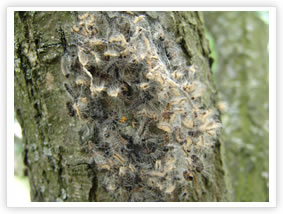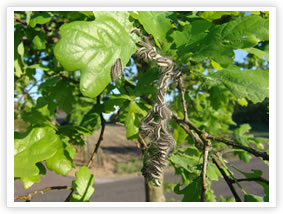

 |
Oak Processionary MothThaumetopoea processioneaTake Action NowGristwood and Toms have considerable experience working where the Oak Processionary Moth is prevalent, and have developed effective ways to treat and restrict its spread. We have a team on quick response to deal with nests as they are spotted. If you have any concerns that the Oak Processionary Moth might be affecting the trees in your area, then now is the time to act. The earlier they are spotted, the better chance there is of containment. Contact Gristwood & Toms for immediate help and advice. IntroductionThe Oak Processionary Moth (OPM) is a major defoliator of oak in Europe. The larvae (caterpillars) feed on the foliage of many species of oaks, including English, Sessile and Turkey oaks (Quercus robur, Q.petraea and Q.cerris). Hornbeam, hazel, beech, sweet chestnut and birch are also reported to be attacked, although mainly when growing next to severely defoliated oaks. Oak Processionary Moth is also a risk to human health. The larvae (caterpillars) are covered in irritating hairs that contain a toxin and contact with these hairs, or their inhalation, can result in skin irritation and allergic reactions. These problems are significant because the Oak Processionary Moth is often most abundant on urban trees, along forest edges and in amenity woodlands. Oak Processionary Moth is a native species of central and southern Europe, where it is widely distributed, but its range has been expanding northwards, presumably in response to climate change. It is now firmly established in northern France and the Netherlands, and has been reported in southern Sweden. More recently colonies of larvae have been found in parts of London and OPM has even been reported in Sheffield. The moth itself will follow light (road and rail networks) on its journey to find new nesting trees. Not all eggs will necessarily hatch in the first year and as they can survive harsh winters it is feasible that a single tree will need to be treated several times. OPM was first discovered in the UK in Richmond in 2006. A high incidence of rash amongst residents on housing estates led to an investigation by Environmental Health services. A second site was identified on Hanger Lane near the A40, where imported oak trees had been planted at around the same time.
See our main site at www.gristwoodandtoms.co.uk - Click here |
 |
     |
 |